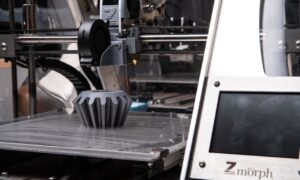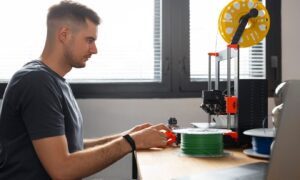In a world inundated with plastic waste and single-use items, the emergence of 3D printing technology has ignited a materials revolution that promises to reshape manufacturing and consumption. “Beyond Plastic: Exploring the Materials Revolution in 3D Printing” delves into this groundbreaking realm, uncovering innovative materials that push the boundaries of what was previously deemed possible. Join us on a transformative journey where sustainable alternatives flourish, possibilities abound, and traditional manufacturing is forever transformed.
Overview of 3D Printing Technology
In the past decade, additive manufacturing, or 3D printing, has emerged as one of the most disruptive technologies in the manufacturing sector. With the ability to create complex geometries and print a wide variety of materials, 3D printing enables the production of parts and products that were once inconceivable.
Today, a diverse range of 3D printers is available, capable of printing in various materials, including metals, plastics, ceramics, and even human tissue. Beyond traditional manufacturing, 3D printing finds applications in the medical and consumer sectors, steadily revolutionizing various industries.
As technology continues to evolve, the realm of possibilities for 3D printing is bound to expand even further, unlocking more astounding applications in the years to come.
Benefits of 3D Printing
The advantages of 3D printing are manifold and continuously growing with advancements in the technology. Chief among them is the capacity to produce complex shapes and structures that were once impossible with traditional manufacturing methods. This includes items with moving parts or intricate internal features.
Furthermore, 3D printing is lauded for its speed and efficiency. The conventional process of creating prototypes can be lengthy and costly. However, with 3D printing, prototypes can be swiftly and affordably produced, allowing for more iterations and faster development times.
Environmentally, 3D printing presents benefits over traditional manufacturing. Its ability to produce objects with less material reduces waste generated during the production process. Many 3D printed materials are also reusable or recyclable, further contributing to waste reduction.
As the technology progresses, the potential benefits of 3D printing will continue to expand. Already, this transformative technology is altering manufacturing practices, product design, and pushing the boundaries of what is deemed possible.
Types of Materials Used in 3D Printing
A wide array of materials can be utilized in 3D printing, ranging from plastics to metals to ceramics. Each material possesses unique properties that make it suitable for specific applications.
Plastics are the most commonly used materials in 3D printing due to their affordability and ease of printing, making them ideal for prototyping and low-volume production. ABS and PLA are the two most popular plastics used in 3D printing. ABS offers greater strength and durability than PLA but can be more challenging to print with and has a higher risk of warping during the printing process.
Metals are also employed for prototyping and low-volume production, although they are generally more expensive than plastics. Stainless steel, aluminum, and titanium are the most common metals used in 3D printing, each having its own set of advantages and disadvantages suitable for specific applications.
Ceramics find applications in both prototyping and mass production but carry a higher risk of breakage during the printing process. Porcelain and glass are the two primary ceramics used in 3D printing.
Applications of 3D Printing in Various Industries
The applications of 3D printing span various industries, and as the technology evolves, its reach continues to expand. Examples of 3D printing applications in different sectors include:
Healthcare: Customized medical implants and prosthetics, surgical planning models, drug development, and delivery.
Architecture: Design prototyping, construction planning and modeling, restoration, and conservation.
Consumer Goods: Customizable jewelry, eyewear, home decor, toys, and games.
Automotive: Functional prototypes, end-use parts, production tooling.
Aerospace: Aircraft and spacecraft components, engine parts, tools, and production aids.
Education: 3D printing curriculum, hands-on projects for engineering, mathematics, and science, rapid prototyping for small-scale projects.
Manufacturing: Prototyping and production tooling, custom one-off parts, 3D modeling of product lines, production aids such as jigs.
Food: Personalization of food items, bakery designs, custom packaging, restaurant, and catering displays.
Sports: Lightweight, customized sports equipment, weight training aids, one-off designs for athletes.
Defense: Weapon system components, battlefield medical supplies, unmanned systems, equipment customization and repair, virtual training.
Emerging Trends in 3D Printing Technology
The landscape of 3D printing technology is rapidly evolving, with new materials and processes being developed constantly. Some of the emerging trends set to revolutionize 3D printing include:
Metal 3D Printing: The ability to print using metal opens new possibilities for creating objects with intricate detail and robust durability. Companies like GE and Airbus are already employing metal 3D printing to create complex parts for their products.
Hybrid Machines: Combining different processes (such as milling and 3D printing) in hybrid machines allows for the creation of parts otherwise impossible with a single process. This offers more flexibility for designers and engineers to push the boundaries of what can be achieved with 3D printing.
Multi-Material Printers: These printers can simultaneously print with multiple materials, enabling the creation of objects with different properties, such as colors or hardness, in a single print job. This opens up new possibilities for complex and customized designs.
Sustainable Materials: The focus on using sustainable materials in 3D printing is increasing. Filaments made from recycled materials are being developed, reducing the need for virgin plastics and minimizing the environmental impact.
Cloud-Based 3D Printing: The rise of cloud-based 3D printing platforms, like Shapeways, offers access to a vast array of 3D models that can be printed on demand. This opens up opportunities for entrepreneurs to start businesses selling personalized products or customized versions of existing items.
Common Challenges and Solutions of 3D Printing
While 3D printing offers tremendous potential, it is not without its challenges. Here are some common challenges of 3D printing and their potential solutions:
Warping: To prevent warping, ensure proper bed leveling and even cooling. Using a different type of filament less prone to warping can also help.
Stringing and Oozing: Stringing and oozing can be minimized by calibrating the printer correctly and ensuring the extruder is not clogged. Adjusting filament temperature can also reduce these issues.
Layer Separation: To prevent layer separation, use the correct layer height and bed temperature for your filament type. Implementing a brim or skirt around the object can also enhance layer adhesion.
Conclusion
The future of 3D printing promises to be vastly different from the present, with new and exciting possibilities on the horizon. As companies experiment with alternative materials, the boundaries of what can be achieved through 3D printing will continue to expand. With a growing range of materials available for 3D printing, we have only just scratched the surface of this transformative technology. As research and development continue, we eagerly anticipate the myriad applications these advancements will bring in the years ahead. Beyond plastic, the materials revolution in 3D printing holds the potential to revolutionize manufacturing and create a more sustainable and innovative world.



































